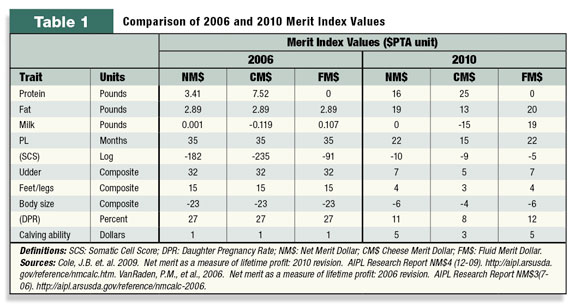There were many changes in the dairy industry in the last five years, and adjustments to genetic bases and net merit indexes are definitely warranted. By utilizing these modifications, improvements to individual herd’s genetic potential, as well as more balanced, profitable cows will continue to improve and become the future of our dairy operations.
It’s hard to believe, but it’s been five years since the last genetic base change and nearly four years since the last update to the Merit Indexes. Reflecting on all the changes in the dairy industry in that time, it makes sense that these revisions are occurring. Highlighted below is a brief discussion on the updates to the indices and the genetic base adjustments.
Net merit index
So let’s review what the net merit index is. Net merit is the expected lifetime profit based on a comparison to the breed base cows born in 2005. Then an estimated value per trait, which takes into account income and expenses for that trait, is multiplied by the predicted transmitting ability (PTA) of that trait, and then summed across all traits in the index. Table 1 compares the value from all three merit indexes in 2006 and the new 2010 versions.

In 2010, only value adjustments for yield traits, SCS and body size composite occurred. The rest of the values were based on 2006 derivations. The main changes, base milk price of $14.93 (14.36 after correction for hauling charges) were used to estimate the value of milk, fat and protein. Adjustments for increased feed costs and extra health costs were also used to adjust the yield trait economic values.
As for SCS and body size composite, there were some minor adjustments. SCS value was set at negative value to reflect the loss of possible quality premiums and higher labor costs, medications, and potential discarded milk/milk shipments. Remember that an adjustment for reduced yield in higher SCS is already accounted for in the PTA of milk due to the negative relationship between PTA SCS and PTA milk. In relation to body size composite, composite indexes are utilized instead of individual PTA’s for all type traits, which are provided by the respective breed associations. One new adjustment to the value of body size composite is the adjustment for higher feed costs in relation to the size of the animal. In short, a greater economic value is given to animals with smaller size that still produce a quality product.
Cheese merit and fluid merit
These indexes are similar to that of net merit, but have slightly different weights for specific traits. In cheese merit, there is more emphasis on protein, less milk pounds and greater value of higher milk quality. Fluid merit focuses more on milk and fat production, and slightly less value on milk quality compared to net merit and cheese merit. Use of these indexes (in relation of net merit) depends on what the genetic progress is warranted for your herd. It is important to remember these indexes are comprised of multiple traits (production, health and type) and allow for a balanced genetic comparison of sires and improvement of a dairy herd.
Genetic base change
You may be wondering what a genetic base change is and why it is done. Since 1984, the U.S. have adjusted the genetic base of dairy cattle evaluations every five years or so. Genetic evaluations are essentially a comparison of an animal to a given base population. Instead of having these numbers grow and grow, periodic adjustments are made to keep the value of PTAs from continually gaining. So starting in January 2010, PTAs calculated will be compared to the PTAs of cows born in 2005 instead of 2000, as it’s been since February 2005. It’s important to remember that these changes are applied to all evaluations and a particular animal’s PTA will likely decrease when the base is changed, but should remain fairly constant.
In summary, there were many changes in the dairy industry in the last five years, and adjustments to genetic bases and net merit indexes are definitely warranted. By utilizing these modifications, improvements to individual herds’ genetic potential, as well as more balanced, profitable cows, will continue to improve and become the future of viable dairy operations. PD
References omitted due to space but are available upon request by emailing editor@progressivedairy.com.
—Excerpts from Penn State Dairy Focus Newsletter, Vol. 11 No. 1
Rob Goodling is and extension educator with Penn State University. Email Rob Goodling.





